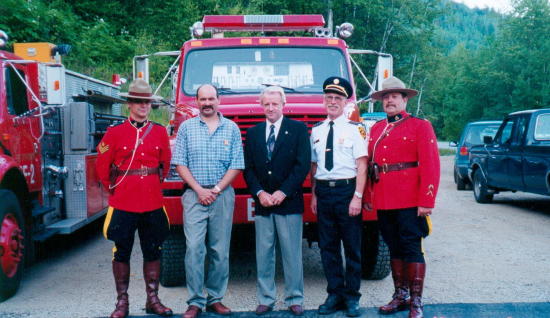
Al Craft is Chief of the Beasley Fire Department, CrewChief of the Beasley Rescue Society and a 40+ year veteran of British Columbia Search and Rescue. All three organizations are volunteer. He is trained in Mountain Rope Rescue (BC), Industrial Rope Rescue, First Responder 3 emergency medical (Provincial), Ground and Air Search (Provincial/Federal CASARA) and has completed his swiftwater rescue technician (SRT1) designation. Duncan Wassick is a career helicopter pilot for Kokanee Helicopters (was Canadian Helicopters) in Nelson, certified with Parks Canada for long line rescue and the BC Ministry of Forests for helicopter rappel. He has 25+ years' experience flying all types of helicopters. Both Wassick and Craft educate the RCMP, local police, paramedics and fire/rescue personnel on helicopter safety and hover entry/exit. For years, they have been offering education to emergency personnel at no cost.
On this particular day, Wassick and Craft happened to be attending an annual fly-in for the city of Grand Forks. Attendance was low, as the weather was cloudy and the area was experiencing spring floods. The two began hiring out to locals, flying them over lake and river properties to inspect damage. During a break for fueling, they were approached by Grand Forks Search and Rescue for an emergency involving individuals trapped in the Kettle River. Five canoeists had attempted to run the river, and three people were caught on logs and flood debris after their canoes overturned in the flooding.
On arrival at the scene, Wassick and Craft were briefed by the RCMP. The incident commander explained that two of the five victims had been washed downstream and had eventually made it out to get help, but another three were still in the river, well out from the shore. All three were above water on logs or debris, but could not dry out because of clouds and spray. One canoe had been completely destroyed, while the other was caught in debris with one victim on top of it. Boat rescue attempts had been aborted earlier because of whitewater conditions. The RCMP had responded with their helicopter, but because of the size of the river and his lack of experience maneuvering over moving water (which is much more difficult than it looks), the RCMP pilot had had to make the difficult decision to stand down.
The three victims had now been in the river for three and a half hours. Cold and exhausted, they were no longer responding to shore crews. Discussions with incident command and the other pilot determined that the only course of action available under the circumstances would be a potentially dangerous hover entry. After removing the doors and unnecessary gear from the helicopter, Wassick flew Craft out to the first logs where Craft worked from the skid to pick up the first victim, a six year-old boy who was barely conscious. After buckling the boy in, Craft briefed the boy's father on correct entry procedures before safely helping him in. They returned to shore where the first two patients were received by waiting ambulance crews. The third individual was on top of the overturned canoe stuck in flood debris. Wassick flew out and hovered close to the canoe, where Craft did a pantomime of entry techniques before they flew closer and helped the individual into the helicopter. All three people were hospitalized for hypothermia, but there were no fatalities..jpg)


